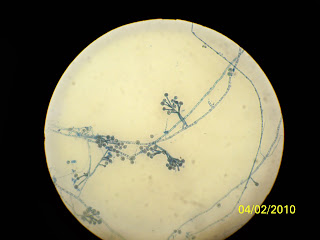- normal habitat: soil
- can cause pulmonary infection when inhaled
Blastomyces dermatitidisBlastomyces dermatitidis tissue section
Blastomyces dermatidis mycelial phase
Conidia wider than pointer 4-5 micrometer
Blastomyces dermatitidis yeast phase (lactophenol blue wet mount)
Yeast wider than pointer 8-20 micrometer
Blastomyces dermatitidis tissue section (Gomori silver stain)
yeast wider than pointer (8-20 micrometer)
Histoplasma capsulatum
Histoplasma capsulation in brain tissue (Gomoro stain)
Magnification 100X
Histoplasma capsulatum in tissue
100X
Histoplasma capsulatum mycelial phase (slide culture wet mount)
8-20micrometer, 400X
note the spiky conidia
Paracoccidioides brasiliensis
No sexual phase
37 deg C: multiple buds yeast with narrow bases (multinucleate, need sulfur containing aminoa acid)
Disease: Lesions [due to conidia inhalation]
Subclinical (no symptom just flu, nodules & plaques)
Chronic unifocal (adult smoker, whose 1 lung infected)
Chronic multifocal (resemble TB, cough, chest pain, weight loss)
Subjuvenile
AIDS
Distribution:
South, Central America
humid Summer & dry Winter
Rural>>Urban
Clinical disease M>>F
-Estrogen inhibit tranformation of Y to H
-Estrogen bing protein found in cytoplasm
Diagnose:
Skin test
Serological test
Paracoccidioides brasiliensis yeast phase (lactophenol blue wet mount)
10-60 micrometer
multiple buds with narrow bases
Paracoccidiodes brasiliensis tissue section (Gomori stain)
multiple buds with narrow bases
Agents that cause Mycetoma
granule from Mycetoma (Madura foot)
causative agent: fungus
Coccidiodes immitis
"immitis" = not mild, severe biohazard
18S rRNA
25 deg C: septate hyphae & alternating arthroconidia with disjunctions that lyse [saprophytic that ruptures with wind]
37 deg C: slimy polysaccharide, yeast with large endospores [in host]
Habitat: alkali soil, arid climate (southern Arizona, central California, Southern New Mexico, & west Texas)
Disease: MOST DANGEROUS SYSTEMIC MYCOSES
Acute Coccidiodomycetoma [inhaling the arthroconidia, effect ppl with low immune system]
-endospores germinate in the lungs (rare, but lethal)
-erythema nodusum (red infected lumps)
-Adult M> Adult F (hormomal control)
Chronic cutaneous Coccidiodomycosis
-High risk for: HIV patients, organ transplant, pregnant woman (hormone)
Diagnose:
Skin test
Serological test
Microscopy
Coccidiodes immitis sperule
note the large endospores
Coccidiodes immitis sperule in human lung tissue (Gomori silver stain)
Coccidioides immitis sperule (KOH mount)
spot the endospore
Artifact: this is fat globule that can be mistaken for sperule or yeast.
Geotrichum mycelia (lactophenol blue wet mount)
Coccidiodes immitis mycelial phase (Lactophenol blue wet mount)
Sporothrix schenckii
- dimorphic
- 22 deg C: fine septate hyphae with cluster of conidia
- 37deg C: elongated yeast cells with cigar-shaped buds (the form when they infect tissues)
Habitat: soil, animal excreta, living or decaying vegetative
Disease: Sporotrichosis [caused by animal bites, rose thorns, insect sting...]
-papule enlarges overdays or weeks
-can persist for years
-does not cure without treatment
-erythematous(redness from inflamation), ulcerated, pus
Sporothrix schenckii yeast phase from a laboratory mouse
smaller than pointer 1-3 micrometer
look for cigar shaped yeast
Sporothrix schenckii yeast phase lactophenol blue wet mount
look for cigar shaped yeast
Sporothrix schenckii mycelial phase (stain of slide culture)
very fine, delicate
smaller than pointer














































